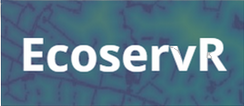InVEST (Integrated Valuation of Ecosystem Services and Trade-Offs)
Visit Tool
InVEST (Integrated Valuation of Ecosystem Services and Trade-offs) is a suite of open-source software models for mapping and valuing the ecosystem services provided by land and seascapes. It uses data about the environment to explore how changes in ecosystems are likely to affect the flow of benefits to people. It is designed to inform decisions about natural resource management.
Information Requirements
Input
Predominantly GIS / map data; information tables (usually.csv format)
Output
Maps; Quantitative data on ecosystem services; Tables / statistics / reports
Resource Requirements
All InVEST models are available as stand-alone software. Models can be run through a graphical user interface or directly in python, for users with coding skills. You will need a mapping software such as QGIS or ArcGIS to prepare certain inputs and to perform any further analysis (e.g., overlays). No specific software is needed to view TIFF outputs. For more info on using InVEST directly in python: https://invest.readthedocs.io/en/latest/ Applications may also be written using InVEST models via its python API.
How does it work?
InVEST is designed to inform decisions about natural resource management in terrestrial, freshwater and marine ecosystems. The models use input data (map/GIS data and information in tables) to explore how changes in ecosystems are likely to affect the flow of benefits provided to people.
It consists of 22 software models (there are currently (as of 3.9.0) 22 models (not including routing, watershed delineation utilities, not including preprocessors, RBSG) for mapping and valuing ecosystem services, plus a number of supporting tools to help with preparing, processing and visualising data. Models can be applied at multiple scales. Most models use a ‘production function’ approach, meaning that the ecosystem service output (map) is derived using information about environmental condition and processes. The final map result is expressed in either biophysical terms (i.e. a quantity) or economic terms. InVEST is suitable for users who wish to look at multiple services or have multiple objectives for their area of interest.
Detailed Information
Key data sources:
Terrestrial, freshwater or marine focus?
- Terrestrial
- Freshwater
- Marine Focus
User Time Requirements:
Simple analysis – 1 day. Detailed stakeholder engagement project – several years.
Developer Organisation
The Natural Capital Project – a partnership based at Stanford University that includes WWF (World Wildlife Fund), The Nature Conservancy, the Institute on the Environment at University of Minnesota, Stockholm Resilience Centre and the Chinese Academy of Sciences.
Other Information
Limitations and assumptions of each model are clearly explained in the information provided by tool developers.
Clear methodologies provided for each model.
Time required depends on data need and availability to support modelling. Time can be reduced if the literature that can be used to parameterize the models is compiled beforehand.
InVEST developers are working on building models that will use globally available datasets and will better incorporate beneficiaries.
Third Party Reviews/ Cross:
Bagstad et al. (2013) conducted a comparative assessment of decision-support tools for ecosystem service quantification and valuation in the San Pedro river basin, Arizona, USA. The key findings were that InVEST is appropriate in contexts where ecological processes are well-understood but many models can be data and time-intensive to apply.
Nemec et al. (2013) surveyed users of a number of GIS models for mapping ecosystem services, including InVEST and ARIES, in 2011. They concluded that the strengths of InVEST, as identified by survey respondents, included ease of use, simplicity, good selection of important ecosystem services, peer-reviewed methodology and multi-functionality, plus the growing community of users that share information within a supported InVEST forum, as well as support offered from the developer team.
InVEST was also reviewed in the 2013 Natural England review of green infrastructure valuation tools carried out by eftec/Cascade (access report here).
ARIES Explorer (k.Explorer) [86] will provide an easy to use interface. A user will click an area and search their storyline or question in the knowledge dictionary e.g. ‘Carbon’. Using a drag and drop approach, the platform will run the model (according to global models or user-specific models uploaded) and provide an output for the study area.

